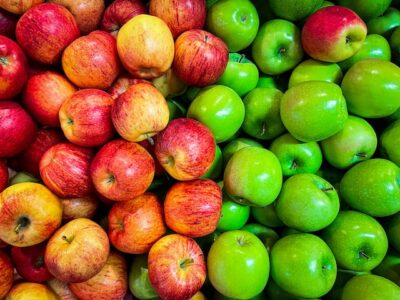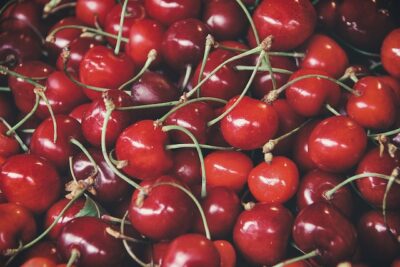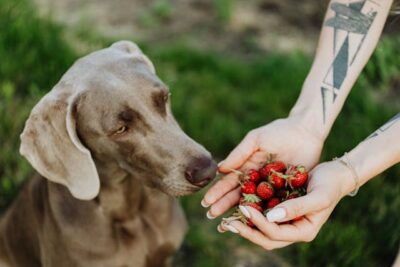Introduction: What Fruits Can Dogs Eat

Welcome to our guide on what fruits can dogs eat in 2024! As pet owners, we often wonder what treats are safe and healthy for our furry friends. Fruits can be a great addition to your dog’s diet, offering not only a tasty snack but also a variety of health benefits.
When considering what fruits can dogs eat, it’s important to know which ones are safe and which ones to avoid. Safe fruits for dogs include apples (without seeds), bananas, blueberries, strawberries, and watermelon (without seeds or rind).
These fruits can be a healthy and tasty addition to your dog’s diet, providing essential nutrients and hydration.
In this article, we’ll explore some of the best fruits for dogs, how to safely incorporate them into their diet, and which fruits to avoid. Let’s ensure our pups stay happy and healthy with these delicious and nutritious treats!
Importance of a balanced diet for dogs
Ensuring that your dog has a balanced diet is crucial for their overall health and well-being. Incorporating fruits into their diet can provide essential vitamins, minerals, and antioxidants that support their immune system, digestion, and skin health.
What fruits can dogs eat? However, it’s important to remember that fruits should only be given in moderation as treats, as some fruits can be high in sugar and may cause digestive issues if consumed in large quantities. Always consult with your veterinarian before making any significant changes to your dog’s diet to ensure they are getting the nutrition they need.
Purpose of the article
The purpose of this article is to provide dog owners with a comprehensive guide on safe fruits for their pets. It aims to educate readers about the nutritional benefits of fruits for dogs, helping them make informed decisions about their pet’s diet.
What fruits can dogs eat? By highlighting which fruits are safe and how to incorporate them into their dog’s meals, the article seeks to promote the health and well-being of canine companions.

Understanding a Dog’s Diet
Basic dietary needs of dogs
Understanding a dog’s diet is essential for their health and longevity. Dogs require a balanced diet that includes protein, carbohydrates, fats, vitamins, and minerals to thrive.
Proteins are crucial for muscle development and repair, while carbohydrates provide energy. Fats are necessary for healthy skin and coat, as well as for the absorption of certain vitamins.
Vitamins and minerals are essential for overall health, supporting various bodily functions. By ensuring that your dog’s diet meets these basic dietary needs, you can help them live a happy and healthy life.
When considering what fruits can dogs eat, it’s important to know which ones are safe and which ones to avoid. Safe fruits for dogs include apples (without seeds), bananas, blueberries, strawberries, and watermelon (without seeds or rind). These fruits can be a healthy and tasty addition to your dog’s diet, providing essential nutrients and hydration.
However, it’s important to feed them in moderation and remove any seeds, pits, or rinds, as these can be harmful to dogs. If you’re unsure about whether a specific fruit is safe for your dog, consult your veterinarian for advice.
Role of fruits in a dog’s diet
Fruits play a valuable role in a dog’s diet, providing essential vitamins, minerals, and antioxidants. They can aid in digestion, boost the immune system, and contribute to overall health and well-being. However, it’s important to feed fruits to dogs in moderation and to avoid fruits that are toxic to them, such as grapes and raisins.
When considering what fruits can dogs eat, it’s important to know which ones are safe and which ones to avoid. Safe fruits for dogs include apples (without seeds), bananas, blueberries, strawberries, and watermelon (without seeds or rind).
These fruits can be a healthy and tasty addition to your dog’s diet, providing essential nutrients and hydration.
However, it’s important to feed them in moderation and remove any seeds, pits, or rinds, as these can be harmful to dogs. If you’re unsure about whether a specific fruit is safe for your dog, consult your veterinarian for advice.
By incorporating safe fruits into their diet, dog owners can enhance their pet’s nutrition and offer them a tasty and healthy treat option.
Factors to consider before feeding fruits to dogs
Before feeding fruits to dogs, several factors should be considered to ensure their safety and health. Firstly, it’s important to check if the fruit is safe for dogs to consume, as some fruits can be toxic to them. Secondly, fruits should be given in moderation to prevent digestive issues and excess sugar intake.
When determining what fruits can dogs eat, it’s crucial to select safe options such as apples (without seeds), bananas, blueberries, strawberries, and watermelon (without seeds or rind). These fruits can provide essential nutrients and hydration to your dog’s diet.
However, it’s important to feed them in moderation and remove any seeds, pits, or rinds, as these can be harmful to dogs.
Additionally, fruits should be washed thoroughly and fed in small, manageable pieces to avoid choking hazards. Finally, consulting with a veterinarian before introducing new fruits to a dog’s diet is advisable, especially for dogs with specific health conditions or dietary restrictions.

Safe Fruits for Dogs
Apples
Benefits for dogs
Apples are a safe and healthy fruit for dogs, offering a range of benefits. They are rich in vitamins A and C, which support immune health and promote healthy skin and coat.
The crunchy texture of apples can also help clean teeth and freshen breath. However, it’s important to remove the seeds and core before feeding apples to dogs, as these parts contain cyanide, which is toxic to dogs in large amounts.
Overall, feeding apples in moderation can be a nutritious and enjoyable addition to a dog’s diet.
How to feed apples to dogs
When feeding apples to dogs, it’s important to prepare them properly. Start by removing the core and seeds, as these parts can be a choking hazard and contain cyanide, which is toxic to dogs. Cut the apple into slices or small pieces to make it easier for your dog to eat.
You can also cook or puree apples and mix them with your dog’s regular food for a tasty and nutritious treat. As with any new food, introduce apples gradually to monitor your dog’s reaction and ensure they tolerate them well.

Bananas
Nutritional value for dogs
Bananas are a nutritious fruit for dogs, rich in essential vitamins and minerals. They are a good source of potassium, which supports heart health and muscle function.
Bananas also contain vitamins C and B6, which are important for immune health and energy metabolism.
Additionally, bananas are low in sodium and cholesterol, making them a healthy treat option for dogs. However, bananas should be fed in moderation due to their sugar content.
Recommended serving sizes
When feeding bananas to dogs, it’s important to consider the recommended serving sizes. For small dogs, a few small slices of banana can be a suitable serving. Medium to large dogs can have slightly larger portions, such as half a banana or a few slices.
It’s best to introduce bananas gradually into your dog’s diet to monitor their tolerance and prevent digestive issues. Remember to remove the peel before feeding, as it can be difficult for dogs to digest.

Blueberries
Antioxidant properties
Blueberries are packed with antioxidants, making them a beneficial fruit for dogs. Antioxidants help combat free radicals in the body, which can contribute to aging and disease.
The high levels of antioxidants in blueberries can help support a dog’s immune system and overall health. Additionally, blueberries are low in calories and contain fiber, making them a healthy snack option for dogs.
Preparation tips for dogs
When feeding blueberries to dogs, it’s best to serve them fresh and washed. You can offer them whole as a treat or mix them into your dog’s food for added flavor and nutrition. Frozen blueberries can also be a refreshing snack for dogs, especially on hot days.
As with any new food, introduce blueberries gradually to monitor your dog’s reaction and ensure they tolerate them well.

Watermelons
Benefits
Watermelons offer several benefits for dogs. They are hydrating, making them a refreshing treat, especially during hot weather. Watermelons are low in calories and fat, making them a healthy snack option for dogs watching their weight.
Additionally, watermelons are a good source of vitamins A, B6, and C, as well as potassium, which can support overall health and well-being in dogs.
Moderation and serving suggestions
When feeding watermelon to dogs, moderation is key due to its high water content and natural sugars. It’s best to remove the seeds and rind before serving, as these can be difficult for dogs to digest.
Offer watermelon in small, bite-sized pieces to prevent choking hazards. As with any new food, introduce watermelon gradually to monitor your dog’s reaction and ensure they tolerate it well.
How to prepare watermelon for dogs
To prepare watermelon for dogs, start by choosing a ripe watermelon without seeds. Remove the rind and seeds, as they can be difficult for dogs to digest. Cut the watermelon into small, bite-sized pieces, ensuring they are easy for your dog to eat.
You can serve the watermelon pieces alone as a treat or mix them into your dog’s food for added flavor and nutrition. Remember to feed watermelon to your dog in moderation to prevent any potential digestive issues.

Strawberries
Nutritional benefits
Strawberries are a nutritious fruit for dogs, rich in vitamins, antioxidants, and fiber. They are low in calories and fat, making them a healthy treat option.
Strawberries also contain high levels of vitamin C, which can help boost the immune system and promote skin and coat health in dogs. However, strawberries should be fed in moderation, as too much can lead to digestive upset due to their natural sugar content.
How to safely feed strawberries to dogs
To safely feed strawberries to dogs, start by washing them thoroughly to remove any pesticides or dirt. Remove the stems and leaves, as they can be a choking hazard.
Cut the strawberries into small, bite-sized pieces to prevent choking and make them easier for your dog to eat. Offer strawberries as an occasional treat and in moderation, as too much can cause digestive issues due to their natural sugar content.
Serving suggestions and moderation
When serving strawberries to dogs, moderation is key due to their natural sugar content. Offer strawberries as a treat and not as a substitute for a balanced diet.
You can mix strawberries into your dog’s regular food, mash them and mix with yogurt for a frozen treat, or simply offer them whole as a snack. Remember to monitor your dog’s reaction when introducing strawberries to their diet and consult with a veterinarian if you have any concerns.

Moderation and Variety
Importance of moderation in fruit consumption
Moderation is crucial when feeding fruits to dogs to avoid digestive upset and excess sugar intake. While fruits offer health benefits, they should be given as treats and not as a primary source of nutrition.
Variety is also important to ensure a balanced diet, as different fruits offer different nutrients. Consulting with a veterinarian about the types and amounts of fruits to feed your dog can help maintain their health and well-being.
It’s important to know what fruits can dogs eat and to offer them in moderation, alongside a balanced diet, to ensure they receive the nutritional benefits without the risks.
Mixing fruits for a balanced diet
Mixing fruits can help provide a variety of nutrients and flavors for your dog’s diet. For example, you can mix blueberries, strawberries, and bananas into a tasty fruit salad for your furry friend.
This approach ensures that your dog receives a range of vitamins, minerals, and antioxidants. However, it’s important to feed fruits in moderation and avoid fruits that are toxic to dogs, such as grapes and raisins. Knowing what fruits can dogs eat and how to prepare them can help maintain their health and happiness.
Recommended frequency of fruit treats for dogs
The recommended frequency of fruit treats for dogs depends on the individual dog’s size, health, and dietary needs. As a general guideline, fruits should be given to dogs as treats and not exceed 10% of their daily calorie intake.
For most dogs, offering fruit treats a few times a week is sufficient to provide variety in their diet without overloading them with sugars. It’s important to monitor your dog’s weight and overall health when incorporating fruits into their diet and adjust the frequency accordingly.

Fruits to Avoid
Grapes and raisins
Toxic effects on dogs
Grapes and raisins are highly toxic to dogs and should be avoided completely. Even small amounts can lead to severe kidney damage and potentially be fatal.
The exact toxic substance in grapes and raisins is not yet known, so it’s best to err on the side of caution and keep these fruits away from your dog.
If your dog accidentally ingests grapes or raisins, seek immediate veterinary attention.
Signs of grape toxicity in dogs
Signs of grape toxicity in dogs can include vomiting, diarrhea, lethargy, loss of appetite, abdominal pain, dehydration, and ultimately, kidney failure. These symptoms can occur within a few hours of ingestion and require immediate veterinary attention.
Even small amounts of grapes or raisins can be harmful, so it’s crucial to keep these fruits out of reach of your dog. If you suspect your dog has eaten grapes or raisins, contact your veterinarian immediately.

Cherries
Potential risks for dogs
Cherries can pose potential risks for dogs due to several factors. The pits of cherries contain cyanide, which is toxic to dogs if ingested. Additionally, the pits can present a choking hazard or cause intestinal blockages.
Even the flesh of cherries, while not as toxic as the pits, can lead to gastrointestinal upset in dogs. It’s best to avoid feeding cherries to dogs altogether to prevent any potential health issues.
Signs of cherry toxicity in dogs
Signs of cherry toxicity in dogs can include dilated pupils, difficulty breathing, and red gums. These symptoms are caused by the cyanide in cherry pits, which can be harmful if ingested.
In severe cases, cherry toxicity can lead to difficulty walking, seizures, and even death. If you suspect your dog has ingested cherries or cherry pits, seek immediate veterinary attention.

Citrus fruits
Potential risks for dogs
Citrus fruits can pose potential risks for dogs due to their acidic nature. The high acidity of citrus fruits can irritate a dog’s digestive system, leading to vomiting, diarrhea, or gastrointestinal discomfort.
Additionally, the essential oils and psoralens found in citrus fruits can be toxic to dogs, causing symptoms such as drooling, trembling, and difficulty breathing. It’s best to avoid feeding citrus fruits to dogs and opt for safer fruit alternatives.
Safer alternatives for dogs
Safer fruit alternatives for dogs include apples, bananas, blueberries, and strawberries, which are generally well-tolerated and offer health benefits. Safe vegetables for dogs include carrots, green beans, sweet potatoes, celery, and cucumbers, which are low in acidity and less likely to cause digestive issues.
Additionally, fruits and vegetables provide essential vitamins, minerals, and antioxidants that can support your dog’s overall health. When offering fruits and vegetables to your dog, always remove any seeds, pits, and stems, and introduce them in moderation to monitor for any adverse reactions.

Introducing Fruits to Your Dog’s Diet
Gradual introduction of fruits
When introducing fruits to your dog’s diet, it’s important to do so gradually. Start by offering small amounts of fruit and monitor your dog for any adverse reactions.
This gradual introduction allows your dog’s digestive system to adjust to the new food and helps prevent stomach upset.
If your dog tolerates the fruit well, you can slowly increase the amount over time. Remember to always remove any seeds, pits, and stems from the fruit before feeding it to your dog.
Monitoring for any adverse reactions
Introducing fruits to your dog’s diet can be a healthy and tasty addition, but it’s important to monitor for any adverse reactions. To determine what fruits can dogs eat safely, start with small portions and observe for any signs of digestive upset or allergies.
Consult with your veterinarian to ensure the fruits you choose are suitable for your dog’s specific dietary needs and health status.
Consulting with a veterinarian
When introducing fruits to your dog’s diet, consulting with a veterinarian is crucial to ensure their safety and suitability. Discussing what fruits can dogs eat with your vet can help you select the best options based on your dog’s breed, age, and health condition.
They can also advise on appropriate serving sizes and monitor for any potential adverse reactions, ensuring a healthy and balanced diet for your furry friend.

Conclusion: What Fruits Can Dogs Eat
Recap of Safe and Unsafe Fruits For Dogs
When it comes to fruits, it’s crucial to know what’s safe and what to avoid for your canine companions. Grapes, raisins, cherries, and citrus fruits should be avoided due to their potential toxicity and digestive risks for dogs.
However, many fruits are safe and beneficial, such as apples, bananas, blueberries, strawberries, and watermelons, offering a range of essential nutrients and antioxidants.
Consulting with your veterinarian about what fruits can dogs eat can help you make informed decisions about your dog’s diet.
Emphasis on the benefits of incorporating fruits into a dog’s diet
Incorporating fruits into your dog’s diet can offer numerous health benefits. Fruits are rich in vitamins, minerals, and antioxidants that support immune health, digestion, and skin health. They can also provide hydration and help maintain a healthy weight.
By including a variety of fruits in moderation, you can enhance your dog’s overall well-being and offer them a tasty and nutritious treat option. Remember to always check what fruits can dogs eat and consult with your veterinarian before introducing new fruits into their diet.
Encouragement to consult with a veterinarian before making any dietary changes for dogs
Before introducing new fruits or making any significant dietary changes for your dog, it’s essential to consult with a veterinarian. They can provide guidance on which fruits are safe and suitable for your dog’s specific dietary needs and health condition.
Consulting with a vet ensures that you’re providing the best nutrition for your furry friend and helps prevent any potential health issues.
For more helpful articles for dog owners, visit our blog, where we have articles about tips for dog owners to help with dog and puppy care, guides to different dog breeds, and more.
Frequently Asked Questions (FAQs): What Fruits Can Dogs Eat
- Are all fruits safe for dogs to eat?
- No, not all fruits are safe for dogs. Some fruits, like grapes, raisins, and cherries, can be toxic to dogs.
- What fruits can dogs eat?
- Many fruits are safe for dogs to eat in moderation. Some safe options include apples (without seeds), bananas, blueberries, strawberries, and watermelon (without seeds or rind).
- Can dogs eat citrus fruits?
- Citrus fruits can cause digestive upset in dogs and are best avoided.
- How should fruits be prepared for dogs?
- Fruits should be washed thoroughly to remove any pesticides or residues. Seeds, pits, and stems should be removed, as they can be choking hazards or contain harmful compounds.
- Can dogs eat fruit peels or skins?
- It’s best to remove peels or skins from fruits before feeding them to dogs, as they can be difficult to digest and may contain pesticides or other harmful substances.
- How much fruit can I give my dog?
- Fruits should be given to dogs in moderation as treats, not as a primary source of nutrition. Consult with your veterinarian to determine the appropriate amount based on your dog’s size, weight, and overall health.
- Should I consult with a vet before feeding fruits to my dog?
- Yes, it’s always a good idea to consult with a veterinarian before introducing new foods into your dog’s diet, including fruits.




